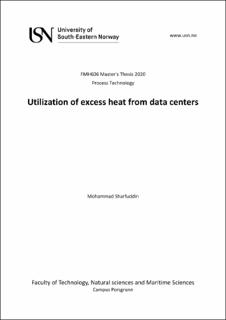| dc.description.abstract | Digitalization has influenced the rapid growth of data centers around the world. The
advancement of IT and telecommunication also played a vital role in is this expansion of
data centers. Data centers facilitate the storage and access of data when required. Electric
power is the main energy input and heat is the main energy output from the data center.
This work is about the utilization of the excess heat which is the by-product of data center
operation. To connect the heat from data centers to a district heating network, a heat pump
might be necessary to increase the temperature of the heat. The economic potential for
different conditions and different heat recovery solutions are evaluated.
Simulations and economical optimization at different conditions in Aspen HYSYS were
carried out. Especially three alternatives were evaluated. The first is an alternative
without a heat pump in which the cooling water leaves the data center at 80 ºC and enters
the district heat network at 70 ºC. The second is an alternative with a slight temperature
increase in the heat pump. The cooling water temperature from the data center is 65 ºC
and the temperature to the district heat system is 70 ºC. The third is an alternative with a
higher temperature increase in the heat pump. The cooling water temperature from the
data center is 65 ºC and the temperature to the district heat system is 80 ºC. The COP
(Coefficient of Performance) in a heat pump for these alternatives were calculated using
the refrigerant R-22 in the simulation program Aspen HYSYS. The estimated economic
potential for each alternative was calculated by estimated values on electricity cost and
district heat price. In one alternative, the electricity cost was specified to 0.1 EUR/kWh,
and the district heat price was specified to 0.05 EUR/kWh. For the alternatives using heat
pumps, the capital cost was estimated assuming that the heat pump investment was
dominating.
The COPs for the two heat pump alternatives were calculated to be 8.66 and 5.4,
respectively. The economy for a large data center facility with recovered waste heat of
200 GWh/year was calculated for 10 years. For the specified conditions, the net present
value was calculated to be large and positive for all the alternatives. As expected, the
most economical alternative was without a heat pump, and the most economical heat pump
was the one with the highest COP. Sensitivity calculations were performed to show
dependencies of temperatures, district heating price, electricity cost, heat pump cost, COP,
and pipeline cost. Pipeline cost is very much dependent on the length and the local
conditions for which it was not possible to make a reasonable estimation.
The calculations show that there is a large potential in using waste heat from data centers
for district heating. | en_US |
